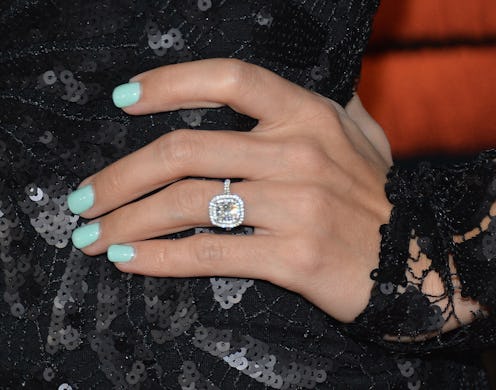Fashion
The Economics of Engagement Rings
New York Times money columnist Tara Siegel Bernard offers a refreshing take on engagement rings. Rather than focusing on cultural trends or what it all means for feminism, Bernard tackles the economics of engagement rings. "At a time when many young people are facing big student debts, a weak job market and rising housing costs, this luxury purchase still appears to be firmly planted on many ring fingers across the country," she notes. But engagement ring spending does fluctuate with the economy, and the recent economic downturn caused average spending on rings to plummet.
Here are American spending averages for 2012, according to the most recent report from trade group Jewelers of America.
- Engagement ring average: $4,000
- ♀ wedding band average: $1,000
- ♂ wedding band average: $500
That's down about 25 percent from 2006, when the pre-recession average was $5,317 for engagement rings. But it's up from 2011, when couples spent an average of $3,538. Bernard also points out that the current price of a high-quality one-carat diamond is $12,700, and though it's not terribly romantic ...
... let’s just pretend for a moment that you invested $12,700 ... in a portfolio of 60 percent stock funds and 40 percent bonds with a real return of 4 percent, that $12,700 would rise to about $27,830 after 20 years, and nearly $41,200 after 30 years (that’s after inflation), according to calculations by Vanguard. If you invested an amount equal to the average ring price, or $4,000, the money would be worth nearly $8,800 after 20 years and almost $13,000 after 30 years.
Though people refer to tradition in defense of diamond engagement rings, the diamond part is a surprisingly recent development. Engagement rings go way back, to Roman times or further, according to the Times, but diamond engagement rings only became a widespread phenomenon after the Great Depression, mainly due to a marketing campaign from diamond conglomerate De Beers.
In the 1940s, Philadelphia advertising agency N.W. Ayer & Son was charged with boosting diamond sales, a task that fell mainly to the firm's one female copywriter, Frances Gerety. Her orders? To "create a situation where almost every person pledging marriage feels compelled to acquire a diamond engagement ring." So... most successful advertising campaign in history?
